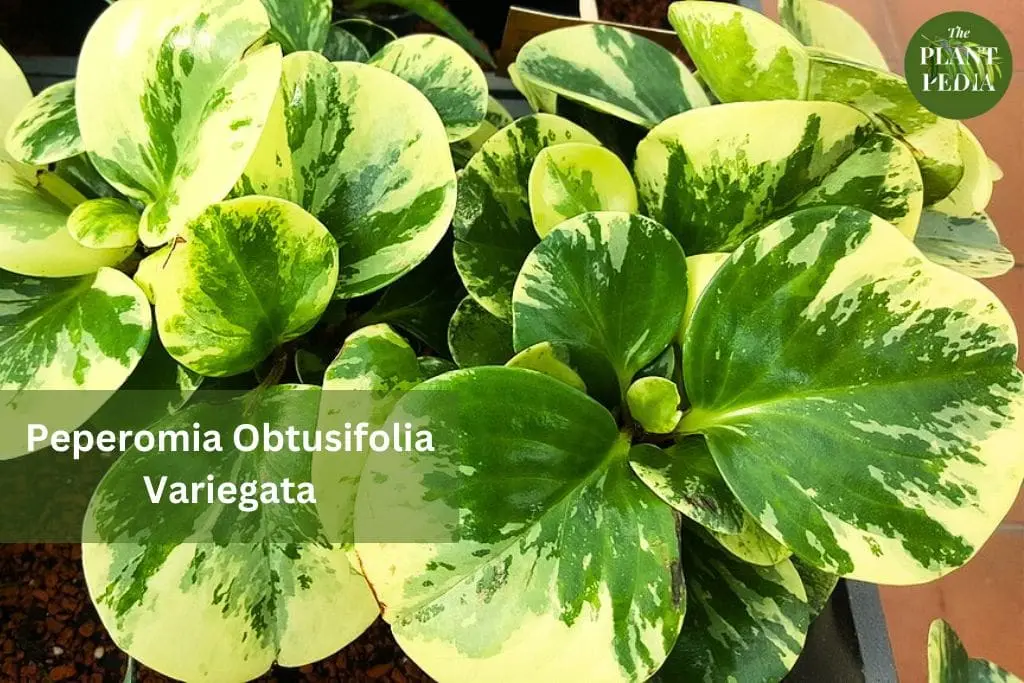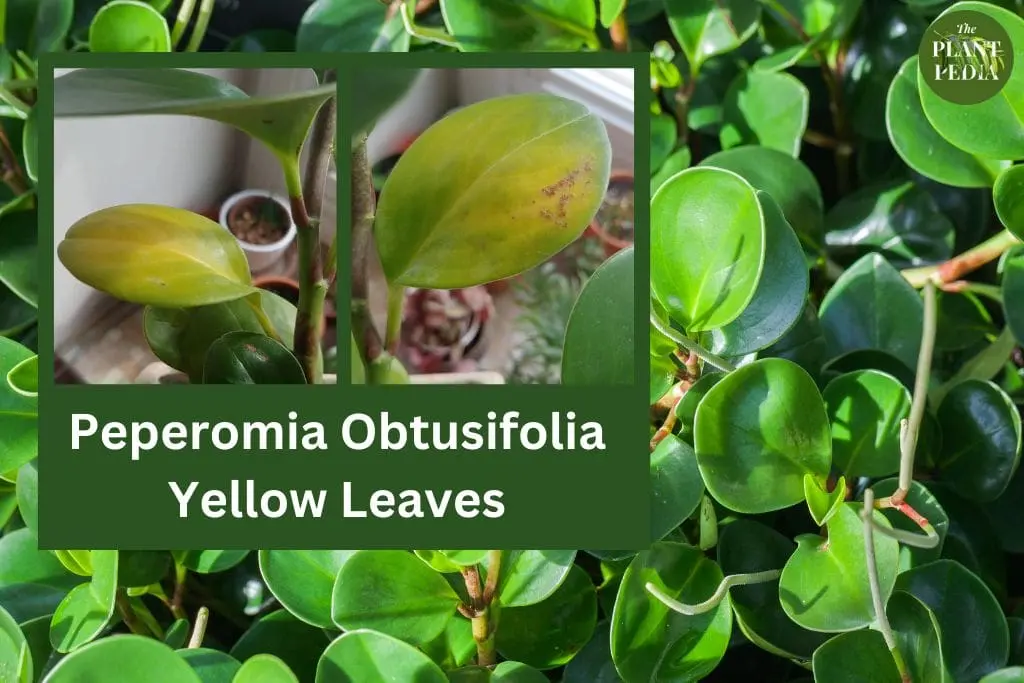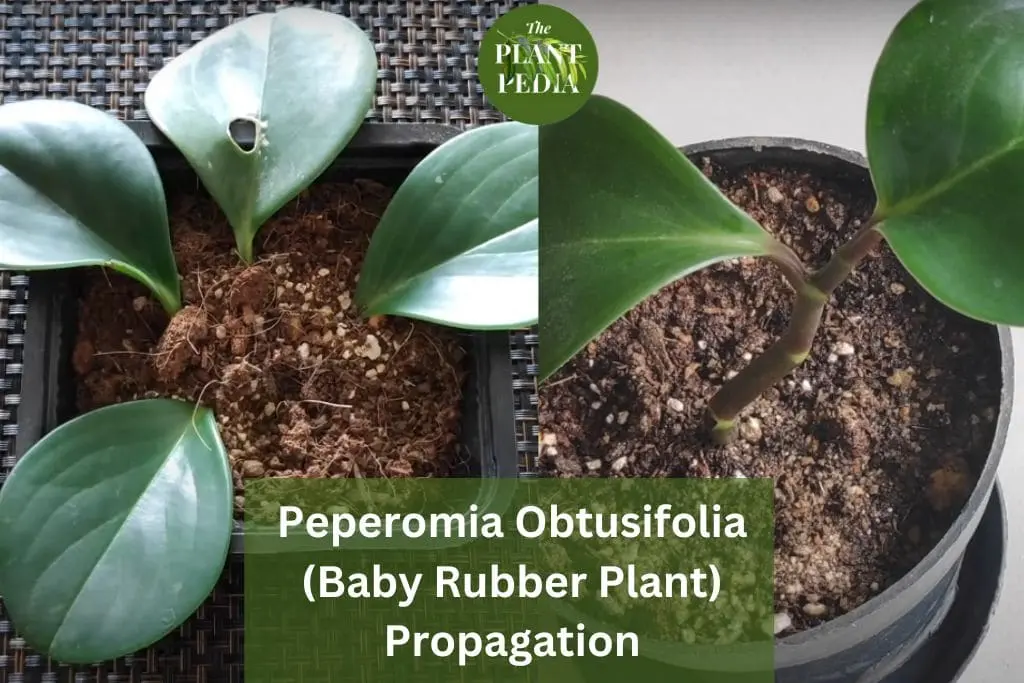Indoor plants have become an integral part of modern interior décor, offering aesthetic beauty and a touch of nature to our living spaces.
Among these, the Peperomia obtusifolia, commonly known as the Baby Rubber Plant or Round Leaf Peperomia, is a popular choice due to its compact size and attractive foliage.
However, it’s not uncommon for Peperomia owners to notice their plant’s leaves turning yellow, which can be a cause for concern.
In this comprehensive guide, we will delve into the various factors that can lead to Peperomia obtusifolia yellow leaves and provide effective solutions to maintain the health and vibrancy of your beloved plant.
The Anatomy of Peperomia Obtusifolia
Before delving into the reasons behind yellow leaves, it’s essential to understand the anatomy and growth patterns of Peperomia obtusifolia.
This knowledge will provide a solid foundation for diagnosing and addressing any issues that might arise.
Peperomia obtusifolia is a compact, bushy plant characterized by its thick, glossy, and succulent-like leaves.
Native to South America, this plant is well-suited for indoor cultivation, thriving in moderate light conditions and requiring minimal maintenance.
Its leaves, which can vary in color from deep green to variegated patterns, are the primary indicator of the plant’s overall health.

Also Read: Peperomia Obtusifolia Variegata: Everything About This Beauty.

Common Causes of Yellow Leaves
Yellowing leaves are often an indicator that something is amiss with your Peperomia obtusifolia.
Several factors can contribute to this phenomenon, ranging from environmental conditions to care routines.
Let’s explore these causes in more detail to gain a deeper understanding of why your beloved plant’s leaves might be turning yellow.
Read: Peperomia Obtusifolia Falling Over: Causes, Care, and Solutions.
Overwatering and Underwatering:
Watering is a delicate balance for Peperomia obtusifolia. Overwatering can lead to root rot, a condition where the roots are constantly submerged in water, leading to reduced oxygen supply and eventual death of the roots.
As a consequence, the plant struggles to absorb nutrients and water, resulting in yellow leaves that may feel mushy to the touch.
On the other hand, underwatering deprives the plant of the necessary moisture it needs to carry out essential processes like photosynthesis.
This can lead to lower leaves turning yellow and wilting as the plant reallocates resources to more critical areas.
Read: Peperomia Obtusifolia Watering: Detailed Guidelines.
Lighting Issues:
Light plays a crucial role in the health of your Peperomia obtusifolia. While it prefers moderate light conditions, it should be shielded from harsh, direct sunlight.
When exposed to too much sunlight, the leaves can develop yellow patches and even show signs of burning along the edges.
Conversely, insufficient light can also lead to yellowing leaves as the plant struggles to produce enough energy through photosynthesis.
Temperature Stress:
Temperature fluctuations can impact your Peperomia obtusifolia’s overall health. These plants thrive in a relatively stable temperature range between 65-80°F (18-27°C).
Exposing the plant to temperatures below 50°F (10°C) can shock its system and cause yellowing leaves as a stress response.
Additionally, sudden drafts of cold air or blasts of hot air from heating systems can lead to leaf discoloration.
Nutrient Deficiencies:
Like all plants, Peperomia obtusifolia requires a balanced diet of essential nutrients to thrive.
Nitrogen and iron are particularly important for maintaining the plant’s vibrant green color.
Nitrogen is a key component in chlorophyll production, and its deficiency can lead to older leaves turning pale yellow.
Iron deficiency, often referred to as chlorosis, can also manifest as yellowing leaves with distinct green veins.
Pests and Diseases:
Your Peperomia obtusifolia can fall victim to various pests and diseases, which can weaken its immune system and lead to yellow leaves.
Pests like spider mites and mealybugs feed on the plant’s sap, depriving it of vital nutrients. In response, the plant may shed its affected leaves, resulting in a yellow appearance.
Fungal infections can also cause yellow spots or patches on the leaves.
Root Bound Conditions:
As your Peperomia grows, its root system also expands. If it becomes root-bound, meaning the roots outgrow the current pot, it can face issues with nutrient uptake and water absorption.
This can lead to a condition known as “pot stress,” where the plant shows signs of unhappiness, including yellowing leaves.
By understanding these common causes of yellow leaves in your Peperomia obtusifolia, you’re better equipped to diagnose the issue and take appropriate measures to restore your plant’s health and vibrancy.
Remember, each cause may present slightly different symptoms, so careful observation is key to accurate diagnosis.
Solutions and Care Tips
Understanding the root causes of yellow leaves in your Peperomia obtusifolia is essential, but equally important is knowing how to address these issues effectively.
Implementing the right solutions and care tips will help you restore your plant’s health and ensure its lush, green foliage.
1. Optimal Watering Routine:
To combat overwatering, it’s vital to establish a proper watering routine. Check the moisture level of the soil by inserting your finger about an inch deep.
Water only when the top inch of soil feels dry to the touch. When watering, ensure that excess water can drain out of the pot’s drainage holes to prevent waterlogged soil and root rot.
Remember, it’s better to slightly underwater than to overwater your Peperomia.
2. Appropriate Lighting:
Position your Peperomia obtusifolia in a location that offers bright, indirect light. East or north-facing windows are often ideal.
If natural light is limited, you can supplement with a grow light designed for indoor plants.
Avoid placing your plant in direct sunlight, especially during the intense midday hours, as it can lead to leaf burns and yellowing.
3. Temperature Management:
Maintain a consistent temperature within the recommended range of 65-80°F (18-27°C). Keep your Peperomia away from cold drafts, heating vents, and air conditioning units.
Sudden temperature fluctuations can stress the plant and cause its leaves to turn yellow.
4. Nutrient Balance:
A balanced diet is essential for your Peperomia obtusifolia’s well-being. During the growing season (spring and summer), feed your plant with a diluted, balanced liquid fertilizer every 4-6 weeks.
Choose a fertilizer with a balanced N-P-K ratio (nitrogen, phosphorus, and potassium) to provide all the necessary nutrients.
Be cautious not to over-fertilize, as this can lead to fertilizer burn and further damage the plant.
5. Pest Control:
Regularly inspect your Peperomia for signs of pests, such as webbing, tiny crawling insects, or discoloration.
If you detect any issues, isolate the affected plant immediately to prevent the infestation from spreading.
Depending on the severity of the infestation, you can choose from natural remedies like neem oil or insecticidal soap, or opt for chemical treatments as a last resort.
6. Repotting:
If your Peperomia obtusifolia shows signs of being root-bound, it’s time to consider repotting. Choose a pot that’s slightly larger than the current one, with adequate drainage holes.
Gently remove the plant from its old pot, untangle any circling roots, and place it in the new pot with fresh, well-draining soil.
Repotting not only provides space for healthy root growth but also replenishes the soil’s nutrients.
By implementing these solutions and care tips, you’re taking proactive steps to address the issues leading to yellow leaves in your Peperomia obtusifolia.
Remember that plants can take some time to recover, so patience is key. Regular monitoring and adjustments to your care routine based on your plant’s response will help ensure its long-term health and beauty.
Your commitment to providing optimal care will be rewarded with lush, vibrant foliage that enhances the beauty of your indoor space.
Preventive Measures
Preventing yellow leaves in your Peperomia obtusifolia is not only about addressing current issues but also about implementing proactive measures to ensure the ongoing health and vitality of your plant.
By taking preventative steps, you can create a conducive environment for your plant to thrive and minimize the risk of future leaf discoloration.
1. Selecting the Right Pot and Soil:
Setting a strong foundation for your plant begins with choosing the right pot and soil. Opt for a pot with drainage holes to prevent water from accumulating at the bottom.
Select a well-draining potting mix that allows excess water to escape easily, reducing the risk of root rot. A mix formulated for succulents or cacti often works well for Peperomia obtusifolia.
2. Regular Inspections:
Cultivate the habit of inspecting your Peperomia obtusifolia on a regular basis. Look for any signs of pests, diseases, or unusual leaf discoloration.
Pay close attention to the undersides of leaves, where pests often hide. Catching issues early can make a significant difference in preventing the spread of problems.
3. Proper Watering Technique:
Avoid getting water on the leaves when you water your plant. Moisture on the leaves can create a humid environment that promotes the growth of fungal infections.
Instead, water the plant directly at the soil level to ensure that the roots receive the necessary moisture without increasing the risk of diseases.
4. Humidity Considerations:
While Peperomia obtusifolia can tolerate moderate humidity, excessively dry air can stress the plant and make it more susceptible to various issues, including yellowing leaves.
If you live in an arid climate or during the winter months when indoor air tends to be drier, consider using a humidity tray or a room humidifier to maintain optimal humidity levels around your plant.
5. Gentle Pruning:
Regularly inspect your plant for any damaged or yellowing leaves. Gently prune these leaves to encourage new growth and prevent the plant from channeling its energy into struggling leaves.
Pruning also helps improve air circulation and reduces the risk of fungal infections.
6. Consistent Care Routine:
Establish a consistent care routine that includes watering, fertilizing, and maintaining appropriate lighting conditions.
By providing your Peperomia obtusifolia with a stable and predictable environment, you’ll help it thrive and reduce the likelihood of stress-induced yellowing.
7. Quarantine New Additions:
If you’re introducing new plants to your indoor garden, it’s wise to quarantine them for a few weeks before placing them alongside your Peperomia.
This precautionary step helps ensure that new plants aren’t carrying pests or diseases that could potentially spread to your existing plants.
By embracing these preventive measures, you’re taking proactive steps to create an environment that promotes the well-being of your Peperomia obtusifolia.
Consistent care, attentive observation, and a few simple adjustments to your routine can go a long way in preventing leaf yellowing and ensuring that your plant remains a stunning centerpiece in your indoor space.
Related FAQs:
Why are the leaves of my Peperomia obtusifolia turning yellow?
Yellow leaves in Peperomia obtusifolia can be attributed to various factors, including overwatering, underwatering, improper lighting, temperature stress, nutrient deficiencies, pests, diseases, and root-bound conditions.
Each of these issues affects the plant differently, leading to the yellowing of leaves.
How can I determine if my Peperomia obtusifolia is overwatered or underwatered?
The best way to determine whether your plant is overwatered or underwatered is to check the moisture level of the soil.
Insert your finger about an inch into the soil; if it feels wet, the plant might be overwatered. If it feels dry, the plant could be underwatered. Adjust your watering routine accordingly.
Can I place my Peperomia obtusifolia in direct sunlight?
While Peperomia obtusifolia prefers bright, indirect light, it’s best to avoid placing it in direct sunlight, especially during the intense midday hours.
Direct sunlight can scorch the leaves, causing yellow patches and burns. Opt for bright, filtered light or provide shade during the hottest parts of the day.
How often should I fertilize my Peperomia obtusifolia?
During the growing season (spring and summer), you can fertilize your Peperomia obtusifolia every 4-6 weeks.
Use a balanced, diluted liquid fertilizer with an N-P-K ratio of around 10-10-10. Be cautious not to over-fertilize, as this can lead to nutrient imbalances.
Are yellow leaves always a sign of a problem?
While yellow leaves can signal a problem, they aren’t always indicative of a severe issue. In some cases, lower leaves naturally turn yellow and drop off as new growth appears.
However, if a significant number of leaves are turning yellow or if the yellowing is accompanied by other symptoms like wilting or spots, it’s a sign to investigate further.
How can I prevent pests from affecting my Peperomia obtusifolia?
To prevent pests, regularly inspect your plant for any signs of infestation, such as webs, tiny insects, or discoloration.
Quarantine new plants before introducing them to your collection, maintain a clean environment, and ensure proper air circulation. You can also use natural remedies like neem oil or insecticidal soap to deter pests.
Is it normal for the leaves to turn yellow during the winter months?
Some degree of leaf yellowing during the winter months can be normal due to reduced light and lower temperatures.
However, if the yellowing is excessive or accompanied by other issues, it’s worth investigating further to ensure that your plant isn’t facing any additional stressors.
Can I propagate my Peperomia obtusifolia from healthy leaves?

Yes, you can propagate Peperomia obtusifolia from healthy leaves. Select a healthy leaf with its stem intact and place it in water or a well-draining potting mix.
Over time, roots and new growth should develop. Propagation can be a great way to rejuvenate your plant and expand your collection.
Conclusion
In conclusion, the appearance of yellow leaves on your Peperomia obtusifolia serves as a valuable indicator of its overall health and well-being.
By understanding the potential causes and adopting the appropriate care techniques, you can effectively address this issue and ensure the continued vibrancy and beauty of your plant.
Regular monitoring, balanced watering, proper lighting, and proactive pest management are key components of maintaining a thriving Peperomia obtusifolia.
Remember, each plant is unique, so a combination of patience and attentive care will go a long way in nurturing your Peperomia back to its full glory.
